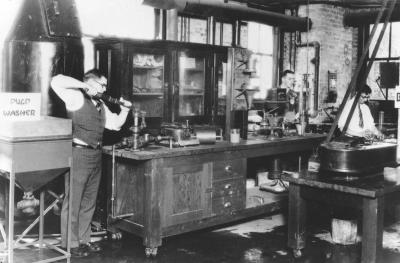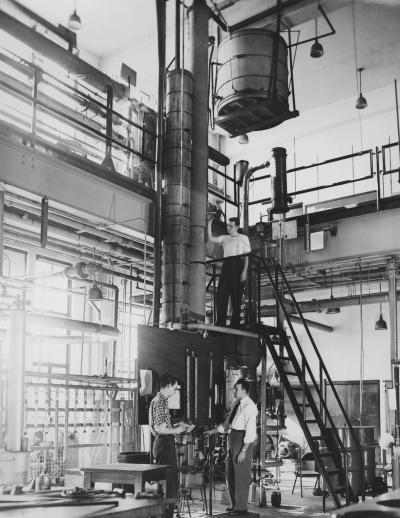January 13, 2005
Chemical engineering at 100: From bubble gum to Pringles, UW department’s alumni have made their mark
Just over a hundred years ago, when chemical engineering made its first appearance at the UW as the new discipline of “industrial chemistry,” students conducted their experiments under the watchful eye of rookie Assistant Professor Henry K. Benson in the basement of Denny Hall, the first building on the current UW campus.
That arrangement didn’t last long, however.
Fumes from the budding engineers’ exploratory ventures into chemical processes threatened to overpower faculty and students who occupied the floors above — so much so, that in 1905 chemistry, including the industrial chemistry courses Benson had been hired to teach, moved to wooden buildings that stood next to Denny Hall.
As the new discipline evolved, so did the UW’s operation, which migrated several times over the years and eventually split from chemistry before landing a permanent home in a new building, named for Benson. Along the way, faculty and alumni left a legacy of life-changing innovations, both weighty and whimsical: PVC, bubble gum, disposable diapers, yellow highway paint, Pringles potato chips and a practical home kidney dialysis machine.
“We do have a tradition of inventiveness and innovation,” said Eric Stuve, department chair. “Chemical engineering in general is the basis of a multitude of things that people take for granted, and our department in particular has contributed some of the really revolutionary inventions.”
The department recently honored that legacy with a Centennial Celebration, gathering hundreds of alumni and friends from across the nation to renew old acquaintances, remember the past, tour current research facilities and speculate on what innovations the department might spawn in its second century.
The early history of the department is closely tied with chemical engineering’s genesis, Stuve says. The UW has one of the oldest chemical engineering programs in the country – only a few others have celebrated a 100th birthday, the most notable being the Massachusetts Institute of Technology, which passed the century mark in 1989.
“We claim our beginnings to the arrival of Henry Kreitzer Benson, who was hired even before he got his Ph.D. to start a series of courses in industrial chemistry in the chemistry department,” Stuve said. “That was in 1904.”
The first product of that program, Horace G. Deming, graduated three years later.
The hiring of Benson was significant because it paralleled some of the formative events of chemical engineering, including the discovery of how to make ammonia.
“That actually occurred in Germany,” Stuve said. “Fritz Haber discovered the process to make ammonia over an iron catalyst by using nitrogen and hydrogen. That meant that ammonia was now available for fertilizers and explosives. Nobody could quite figure out how the Germans were doing it, and Benson, who was a leader in the field, was tapped by national leaders to serve on various ammonia boards to try to solve the problem.”
Eventually, the production of ammonia — and, as a result, the ability to make fertilizer to fuel massive farming operations — became commonplace. And the emerging field of chemical engineering moved on to other problems, using a systems-oriented approach that differentiated it from chemistry.
“That’s the main difference,” Stuve said. “The question is how do you take the chemistry and scale it up into large processes, continuous processes that are designed to be efficient, to maximize the profits and minimize the pollution?”
At the UW, chemistry got its own building after the 1909 Alaska-Yukon-Pacific Exhibition, occupying the Fine Arts Palace built for the event. The structure was renamed Bagley Hall, after the Rev. Daniel Bagley, a Methodist minister who helped convince city officials in early Seattle of the value of pursuing a university for the frontier town. That building, one of just three structures that remain from the exhibition, is now known as Architecture Hall.
In 1919, Benson was named head of the Chemistry Department. Then, in 1925, the American Institute of Chemical Engineers began accrediting programs throughout the United States. To qualify for accreditation, the UW officially split the chemistry program, creating a dual department of chemistry and chemical engineering. Benson became chief executive officer over the new department, and accreditation followed in 1926.
The dual-department arrangement continued until 1953, when chemical engineering became its own department.
On the way, the program relocated a couple more times, first in 1937 when chemistry moved to the new Bagley Hall, located adjacent to Drumheller Fountain. Chemical engineering arrived at its current location with the dedication and opening of Benson Hall in 1966.
While the department was growing, its alumni were busy using their UW-schooled talents to churn out inventions that would change the way we live.
Waldo Semon, a 1924 graduate who at the time was one of the first doctoral degree chemical engineers in the country, discovered a way to convert polyvinyl chloride — PVC — from a hard, difficult to work substance into one that is soft and pliable, and is used in thousands of products, from floor coverings and upholstery to garden hoses and credit cards. In the process, he also made a discovery that has put a smile on the faces of millions of children and adults — bubble gum.
“It looked like ordinary gum, except that it would blow these great, big bubbles,” he said in an interview before his death in 1998 at 100. His employer, B.F. Goodrich, thought it was a defect and nobody would buy the product.
Shortly before World War II, Goodrich sent Semon to Germany to see what he could find out about a new process to make synthetic rubber. The Germans remained tight-lipped.
“He came back and reported to the board of directors,” Stuve said. “And he said, ‘Darn it, if the Germans can do it, then so can we.’” He went on to develop Ameripol, a form of synthetic rubber, and played a critical role in creating government rubber-styrene, a synthetic rubber blend that assisted the Allied effort in the war.
A 1926 graduate, Victor Mills, gets kudos from parents all over the world. He invented Pampers, the first disposable diaper. He also formulated ways to mass produce Jif peanut butter and Duncan Hines cake mix. Other clean sweeps include designing a continuous process to make Ivory soap, the first major change in a 6,000-year-old industry.
And he made Pringles potato chips possible.
“Procter & Gamble apparently had this waste stream of a potatoey substance and wondered, ‘What can we do with this?’” Stuve explained. “They decided that they could make potato chips.”
The problem was they didn’t have a massive distribution system to guarantee freshness. The solution? Make the chips a uniform shape so they could be stacked, then put them in a can, like one used for tennis balls, filled with nitrogen. Blocking exposure to oxygen and ultraviolet light prevented spoilage and gave the chips a long shelf life.
Other innovations included yellow highway paint, invented by 1936 graduate W. Ronald Benson, son of Henry K. Benson, and the first large-scale process to make whole wheat bread, designed by 1943 grad Charles Matthaei.
But perhaps the department’s finest hour so far came in 1964 when UW chemical engineer Les Babb led a team that invented a home kidney dialysis machine, putting life-saving treatment in the hands of thousands of ailing patients who before would have died.
“Babb invented the actual technology for handling the chemicals for dialyzing the blood stream,” Stuve said. “It’s a certain mixture of chemicals that keeps the right proportions at all times as it processes the blood stream.” Babb became an emeretis professor in 1991.
In the 1960s, it was one of several competing technologies, Stuve added. “Today, it is the only technology that is still used for this, and it works in exactly the same way.”
Looking ahead, Stuve said he expects more of the same. Chemical engineering continues to evolve with the times. It has become extremely intertwined with science and mathematics, making practitioners powerfully qualified to tackle issues in such rapidly expanding fields as nanotechnology, biomedicine and photonics.
“The process continues,” he said. “We have people — faculty and alumni — who lead the field, and they’re working on projects that will shape and change our lives.”




